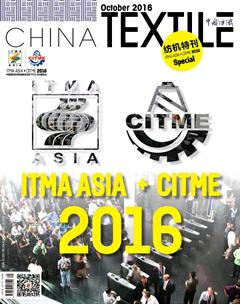中國已成為歐洲強有力的競爭對手
——訪印度紡織機械展覽會協會
?
中國已成為歐洲強有力的競爭對手
——訪印度紡織機械展覽會協會
印度紡織行業正在以8%~10%的速度增長。從紡織行業的新項目以及對建立紡織產業園的重視程度來看,印度紡織機械行業的規模有望在未來7年從目前的22億盧比增長到45億盧比。
該行業在印度已有近60年的歷史,目前已經擁有1000多家機械設備及零部件制造企業。近300家企業可以生產完整的設備,其余的企業從事各種紡織機械零部件的生產。然而,不是所有企業都能全負荷生產或達到最佳負荷水平。目前,印度的國產設備遠不能滿足國內需求。除紡紗設備外,其他版塊的設備,如織造、針織和濕法處理等都缺乏高水平的質量標準和性能(在大多數情況下),很難與歐洲制造商競爭。印度紡機行業內幾乎沒有織造行業的無梭織機(劍桿織機或噴氣織機)和針織圓機和橫機。
目前印度紡機制造分入會和未入會企業兩大板塊。在入會企業中,除了國有有限責任公司外,機械制造都是由獨立的企業完成的,他們是與外資企業合作的合資公司。在未入會的分散板塊中,都是一些小規模的企業、甚至極小工廠在從事零配件生產。大約87%紡織機械都來自以下六個產業集群地,即艾哈邁達巴德、班加羅爾、哥印拜陀、盧迪亞納、孟買和蘇拉特。這些集群地的選址均經過策略性的考量,旨在更好地為紡織行業服務,它們之間互相關聯以便生產紡織行業所需的設備。目前,絕大多數的紡織機械都是內銷,因此出口范圍非常小。
幾年前,歐洲還被認為是紡織機械的最大的制造商,但今天中國已成為其強有力的競爭對手。印度是中國主要的進口合作伙伴,其次是孟加拉國、印度尼西亞、越南和日本等國家。亞洲是中國紡機設備的最大消費國。
中國的紡機出口正穩步增長,預計在2016年將達到30.7億美元,而進口則呈現下降趨勢。對中國紡機設備的需求增長是多方面的,在質量和設備的使用壽命方面仍有很大的改進余地。
中國設備的獨特賣點是成本低。雖然這些機器在全球范圍內出口,但是由于其便宜的價格和地理優勢,亞洲國家是其主要進口伙伴。印度是中國的機械設備進口的最大的合作伙伴。印度進口正以10%的年復合增長率增長,預計到2016年將達到 8.47億美元。印度主要從中國進口針織機械設備,其次是織機。
The Textile industry is witnessing a growth of 8-10 per cent. The size of India's textile machinery industry is poised to double to Rs 45,000 crore in the next 7 years from the present Rs 22,000 crore in light of new projects and emphasis on setting up textile parks.
This industry is nearly sixty years old and has more than 1000 machinery and component manufacturing units. Nearly 300 units produce complete machinery and the remaining produces various textile machinery components. However, not all the units work to full capacity or even the optimum capacity level. Currently, our inhouse production is insufficient to meet domestic demand. Apart from the spinning sector other sector machineries such as weaving, knitting and wet-processing lack high level of quality standard and performance (in most of the cases) to compete with the European manufacturers. In the weaving sector, shuttleless weaving machinery (rapier or air jet) and in the knitting sector (circular knitting and flat knitting) machineries hardly have any presence in the industry.
The machinery manufacturing operation takes place at the organized and the unorganized sectors. In the organized sector, in addition to the public limited companies, machinery manufacturing is done in independent units, which have collaborative joint ventures with the foreign entities. In the decentralized sector, there are small-scale industrial units as well as tiny units engaged in the production of accessories. Around 87 per cent of the total production, i.e., textile machinery is coming from the six clusters namely Ahmedabad,Bangalore, Coimbatore, Ludhiana, Mumbai and Surat. These clusters are strategically located to serve the textile industry and have the affiliation to produce the kind of machinery required by the industry. Currently most of textile machinery is consumed within the country, so there is very less scope for the export.
Till few years back, Europe was considered a biggest manufacturer of textile machineries, but today China is giving tough competition. India is major import partner to China followed by countries like Bangladesh, Indonesia, Vietnam & Japan. Asia is biggest consumer of Chinese machineries. China’s machinery Export is growing steadily & expected to reach USD3.07billion in Year 2016, whereas import is showing decreasing trend. The demand of Chinese machineries is growing multi folds, still there is lot of scope for improvement in terms quality & life of machinery.
The USP of Chinese machineries is its low cost. Though these machineries are exported across the globe, Asian countries are major import partners owing to its cheaper price & geographical advantage. India is the top import partner for Chinese Machineries. Indian imports are growing with CAGR of 10% estimated to reach USD 847 Million by 2016. India is majorly importing knitting machineries from China, followed by weaving machines.
China is giving tough competition to Europe
- Interview with India ITME Society

